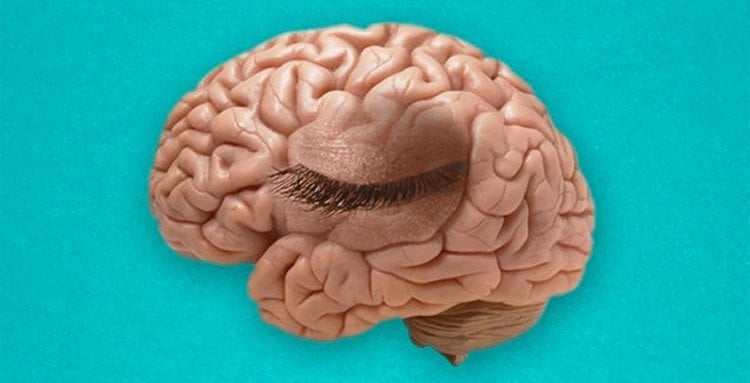Summary: According to researchers, when shifting attention from one spot to another, the brain blinks. They report these blinks are momentary unconscious gaps in visual perception.
Source: Vanderbilt University.
When your attention shifts from one place to another, your brain blinks. The blinks are momentary unconscious gaps in visual perception and came as a surprise to the team of Vanderbilt psychologists who discovered the phenomenon while studying the benefits of attention.
“Attention is beneficial because it increases our ability to detect visual signals even when we are looking in a different direction,” said Assistant Professor of Psychology Alex Maier, who directed the study. “The ‘mind’s eye blinks’ that occur every time your attention shifts are the sensory processing costs that we pay for this capability.”
Details of their study are described in a paper titled “Spiking suppression precedes cued attentional enhancement of neural responses in primary visual cortex” published Nov. 23 in the journal Cerebral Cortex.
“There have been several behavior studies in the past that have suggested there is a cost to paying attention. But our study is the first to demonstrate a sensory brain mechanism underlying this phenomenon,” said first author Michele Cox, who is a psychology doctoral student at Vanderbilt.
The research was conducted with macaque monkeys that were trained to shift their attention among different objects on a display screen while the researchers monitored the pattern of neuron activity taking place in their brains. Primates are particularly suited for the study because they can shift their attention without moving their eyes. Most animals do not have this ability.
“We trained macaques to play a video game that rewarded them with apple juice when they paid attention to certain visual objects. Once they became expert at the game, we measured the activity in their visual cortex when they played,” said Maier.

By combining advanced recording techniques that simultaneously track large numbers of neurons with sophisticated computational analyses, the researchers discovered that the activity of the neurons in the visual cortex were momentarily disrupted when the game required the animals to shift their attention. They also traced the source of the disruptions to parts of the brain involved in guiding attention, not back to the eyes.
Mind’s eye blink is closely related to “attentional blink” that has been studied by Cornelius Vanderbilt Professor of Psychology David Zald and Professor of Psychology René Marois. Attentional blink is a phenomenon that occurs when a person is presented with a rapid series of images. If the spacing between two images is too short, the observer doesn’t detect the second image. In 2005, Zald determined that the time of temporary blindness following violent or erotic images was significantly longer than it is for emotionally neutral images.
Funding: Graduate students Kacie Dougherty, Jacob Westerberg and Brandon Moore from Vanderbilt; Geoffrey Adams from Emory University; Eric Reavis from the University of California, Los Angeles; and David Leopold from the National Institute of Mental Health also contributed to the study, which was supported by the intramural research program of the National Institutes of Health through National Eye Institute grants 1R01EY027402-01 and 2T32 EY007135-21 and National Institute of Mental Health grant F32MH108317.
Source: David Salisbury – Vanderbilt University
Publisher: Organized by NeuroscienceNews.com.
Image Source: NeuroscienceNews.com image is credited to Keith Wood, Vanderbilt University.
Original Research: Abstract for “Spiking Suppression Precedes Cued Attentional Enhancement of Neural Responses in Primary Visual Cortex” by Michele A Cox, Kacie Dougherty, Geoffrey K Adams, Eric A Reavis, Jacob A Westerberg, Brandon S Moore, David A Leopold, and Alexander Maier in Cerebral Cortex. Published online November 23 2017 doi:10.1093/cercor/bhx305
[cbtabs][cbtab title=”MLA”]Vanderbilt University “‘Mind’s Eye Blink’ Proves ‘Paying Attention’ Is Not Just a Figure of Speech.” NeuroscienceNews. NeuroscienceNews, 27 November 2017.
<https://neurosciencenews.com/attention-minds-eye-8040/>.[/cbtab][cbtab title=”APA”]Vanderbilt University (2017, November 27). ‘Mind’s Eye Blink’ Proves ‘Paying Attention’ Is Not Just a Figure of Speech. NeuroscienceNews. Retrieved November 27, 2017 from https://neurosciencenews.com/attention-minds-eye-8040/[/cbtab][cbtab title=”Chicago”]Vanderbilt University “‘Mind’s Eye Blink’ Proves ‘Paying Attention’ Is Not Just a Figure of Speech.” https://neurosciencenews.com/attention-minds-eye-8040/ (accessed November 27, 2017).[/cbtab][/cbtabs]
Abstract
Spiking Suppression Precedes Cued Attentional Enhancement of Neural Responses in Primary Visual Cortex
Attending to a visual stimulus increases its detectability, even if gaze is directed elsewhere. This covert attentional selection is known to enhance spiking across many brain areas, including the primary visual cortex (V1). Here we investigate the temporal dynamics of attention-related spiking changes in V1 of macaques performing a task that separates attentional selection from the onset of visual stimulation. We found that preceding attentional enhancement there was a sharp, transient decline in spiking following presentation of an attention-guiding cue. This disruption of V1 spiking was not observed in a task-naïve subject that passively observed the same stimulus sequence, suggesting that sensory activation is insufficient to cause suppression. Following this suppression, attended stimuli evoked more spiking than unattended stimuli, matching previous reports of attention-related activity in V1. Laminar analyses revealed a distinct pattern of activation in feedback-associated layers during both the cue-induced suppression and subsequent attentional enhancement. These findings suggest that top-down modulation of V1 spiking can be bidirectional and result in either suppression or enhancement of spiking responses.
“Spiking Suppression Precedes Cued Attentional Enhancement of Neural Responses in Primary Visual Cortex” by Michele A Cox, Kacie Dougherty, Geoffrey K Adams, Eric A Reavis, Jacob A Westerberg, Brandon S Moore, David A Leopold, and Alexander Maier in Cerebral Cortex. Published online November 23 2017 doi:10.1093/cercor/bhx305






